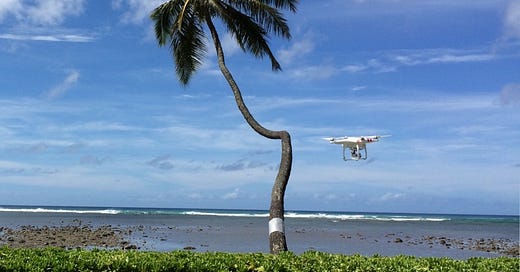New Hawaii Drone Club Forming

Like many geeks, I'm a little obsessed with drones. I still haven't worked up the nerve to fly one, let alone buy one, but I've been tracking the explosion of consumer quadcopters closely. This week brings the first meeting of the Hawaii Drone Club, a new local club for multi-rotor pilots.
The club is led by Ryan "Sal" Salcido, a local aviator who usually flies much larger aircraft, and is chartered through the Academy of Model Aeronautics. The AMA affiliation means that, unlike many casual drone groups, the club's flying events are officially licensed and insured.
"I started the club out of a growing interest in multi-rotor use in Hawaii," Salcido says. "The club is a group of like-minded people and organizations united in the mission to promote responsible, productive and fun use of unmanned systems across the Hawaiian Islands."
Like many drone enthusiasts, Salcido acknowledges right away that the use of the term "drone" is controversial in the community.
"Small Unmanned Aircraft Systems (or sUAS) doesn't roll off the tongue," he laughs. "We are going to discuss it at our first club meeting, but my initial vision is to separate our club from a number of established remote controlled flying clubs here in the islands."
Indeed, remote controlled aircraft clubs have been around for decades, and represent the largest group of pilots and RC craft builders out there. And while those clubs have embraced drones (or sUASes or RPASes and so on), they remain rooted in flying more conventional airplanes and helicopters.
"The main difference I wanted to describe with the Hawaii Drone Club was the incorporation of some level of autonomy or automation with the system," Salcido explains.
The club's four priorities are education, advocacy, outreach and fellowship. And Salcido notes there is definitely a need for education. As drone ownership grows, he says he often sees beginning pilots make some common mistakes.
"The number one mistake I see is flying in neighborhood parks," he says. "As frustrating as it is, Chapter 10 of the Revised Ordinance of Honolulu (ROH) clearly states that flying model aircraft, even for personal or recreational use, is prohibited unless at a designated approved park."
And there are only six approved parks on the island of Oahu, Salcido adds.
Like many quadcopter enthusiasts, Salcido stays up to date with city, state, and federal rules that govern the hobby. And while each year seems to bring new proposals to restrict drone use, he says he hopes the members of the club can stay engaged in civic affairs and become part of the solution.
"Our advocacy team has written a piece of proposed legislation allowing for safe and responsible use in city parks," he explains. "While far from complete, it is the club's hope to be a balanced, responsible voice in advancing drone use."
Salcido argues that when people fly quadcopters in sometimes dangerous and illegal ways, it's in part because the city hasn't provided many options.
"We’re just trying to provide that alternative," he says.
The new club is already busy with other projects as well. "Project Excalibur," for example, gives young patients at the Shriner's hospital in Honolulu a chance to explore the technology, and even get a unique sense of flying.
"Project Excalibur's mission is to introduce these kids to First-Person View (FPV) or vision-equipped drones and hopefully provide a degree of mobility that they might not otherwise have," Salcido says. "The program is only about an hour long, but it’s a way to interact with youth in a fun and safe way."
The name of the club, the proposed city bill, and programs for youth are just some of the items on the agenda of the Hawaii Drone Club's first meeting, which is being held at ProtoHUB Honolulu at 7 p.m. on Thursday, March 26. For more information, visit HawaiiDroneClub.org, or send an email to hawaiidroneclub@gmail.com.











